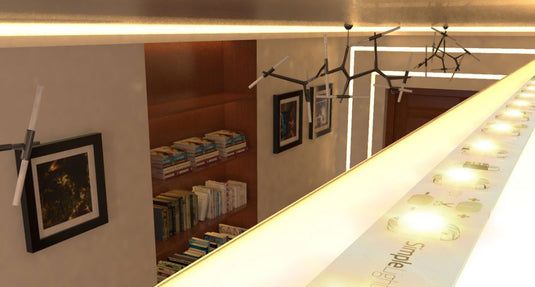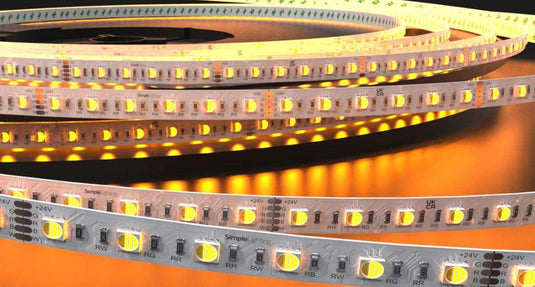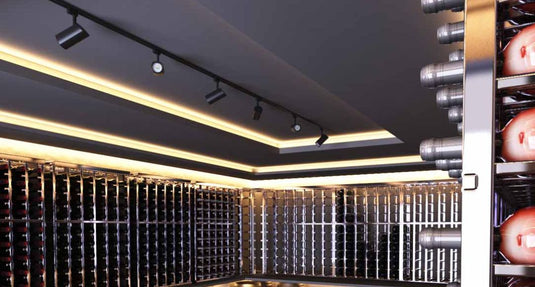Get Prepared: Your DIY Materials Checklist for LED Strip Lights
For a DIY enthusiast, there’s no greater satisfaction than the sense of accomplishment you get when finishing a project with little to no problem. The same is true for a successful DIY LED strip light installation. The ease of installation, customisation freedom, and the ability to change colour and brightness all add to the fulfilment of properly setting up LED strip lights.
We know the feeling. And we’re sure you know too! If you don’t yet, then that’s why you’re here. In this guide, we’ll provide a comprehensive checklist of all the materials you need for a smooth and professional-looking LED strip light installation. Because the biggest headache for a DIYer is realising you don’t have all the materials you need for a project. And we know that feeling, too.
The Core Ingredients: What You'll Need for Your LED Lighting Project
How many times have you made back-and-forth trips to the hardware store because you keep forgetting what is needed for an LED strip lighting project? Would you rather not say? Well, fret not! For your LED strip light installation, you finally have a checklist to help you get everything you need in one trip to the hardware store.
LED Strip Lights
There are several factors to consider when selecting a suitable LED strip light for your project. Ask yourself, what type of strip lights do you need? First, consider location. Is your lighting project indoors or outdoors? For outdoors, you’ll choose one with a high IP rating (at least IP65). Do you need colour-changing properties? If not, then single-colour strip lights will do just fine. But if you need to change the colour of the strip light at some point, or you want strobing, go for RGB lights.
Also, consider the length you’ll need for the entire project. Make sure to get accurate measurements before buying your LED strip lights. Take into account curves, corners, and obstacles when getting the measurements.
Power Supply (Driver)
Now that you know the total length of the LED strip lights you need, get the total wattage based on the length and power consumption of the strips you’re getting. The fastest way to find out is to check the data sheet or the box labels. They would typically show you the power consumption per meter. So, if you’re getting 6 meters of a strip rated 5w per meter, simply multiply the power rating by the total number of meters you’re getting (5w x 6m = 30w).
Others, like LED Supplier, have kits that show you the power rating of the whole run (most of our kits are rated at 36w per 5 meters).
The general rule is only to use 80% of the power supply’s rating to make allowances for unintentional overloads and prevent overheating and premature failure. For the 36w kit, you’ll need a power supply of at least 45w. Anything lower than that will not be suitable.
LED Controller (Optional)
What do you need the LED strip lights for? Are they for ambient lighting or mood setting? Will you need a controller for dimming, colour changing, or other smart LED light features? If you do need them, consider the type of LED strip you’re using and whether they are compatible with the controllers. Many smart LED strip lights offer voice and app control options.
Don't Forget Your Tools! (See Our Separate Guide for Details)
For a smooth LED strip light installation, you need the proper tools to help you complete the job. Basic essential tools include measuring tape, scissors or knife, connectors, and mounting clips. You can check out the LED Strip Light Installation Tool Guide here.
Making the Right Connections: Materials for Modifying Your LED Strips
Solderless LED Strip Light Connectors
While measuring the layout, determine the type and number of connectors you need for the project. Will you need straight, corner, or T-shaped solderless connectors to join sections of LED strip lights? How many will you need? Tip: It’s better to have more than less!
Soldering Supplies (Optional)
This is for advanced and veteran DIYers who prefer to solder the wires together. Have you got a soldering iron, solder, and flux ready?
Wires
What gauge and type of wire do you need to connect the LED strip lights to the power supply and controller? Make sure to consider the voltage and current ratings of your LED strip when choosing the wire. Using the wrong wires could lead to safety hazards, which we don’t want.
Wire Connectors
How are you going to safely and securely connect the wires? Are you using terminal blocks or screw terminals? Screw terminals are typically used to connect individual LED strip lights to power sources, while the terminal blocks are used to connect multiple wires for a larger electrical system.

Keeping Them in Place: Materials for a Secure Installation
Adhesive Backing (on the LED strip)
These are usually pre-applied, and if not, the supplier would usually provide one, so you don’t have to worry about this much. Just take note that they may not be sufficient for all surfaces or long-term use, so we recommend using stronger adhesives in their place.
Strong Double-Sided Adhesive Tape
These are great, especially for installing LED strip lights on uneven surfaces. We do not recommend using the pre-applied adhesive backing alone if you want a longer-lasting, more secure adhesion.
LED Strip Light Mounting Clips and Screws
Will you be using mounting clips instead for a stronger and more permanent installation of your LED strip lights? If so, plan out how many you’ll need. Again, it’s better to have more than less, otherwise you’ll find yourself going back to the store just to get a few more clips.
LED Strip Light Channels/Profiles (Optional)
LED strip light channels are used for three things: cleaner aesthetic, better heat dissipation, and diffusing light. Make sure you have an accurate measurement of how long you’ll need. Since you’ll be inserting the strips inside it, their measurements shouldn’t be too far off.
Cable Clips or Ties
If you want a tidy installation, get some cable ties for a bit of cable management. These keep your wires tucked and secured in one place.
Getting the Power Right: Materials for a Functional Setup
Mains Power Cable (if hardwiring the power supply)
Warning: This should only be done by a qualified electrician! Even if you have experience, still do this with the utmost care. Also, make sure that you have the correct rated cable for connecting to the mains circuit.
Plug and Cable (if using a plug-in power supply)
This is the safer option to connect the LED strip light setup to the mains circuit. Ensure the cable length is sufficient for your installation. This should be part of the consideration when measuring your layout.
Connectors for Power Supply and Controller
Do you have the necessary connectors to link the power supply to the LED strip lights and the controller (if used)? Most LED strip lights have a maximum length for a single run, so you may need multiple power supplies for large projects. Make sure you have the exact amount you need for the whole project.
Safety First, Finish Smart: Essential Extras for Your Project
Insulating Tape
Have a roll ready for any exposed wire connections that may come up during the project.
Cleaning Supplies
Use isopropyl alcohol to clean the surface where you’re mounting the LED strips, using either pre-applied adhesives or a separate, stronger double-sided adhesive.
Going the Extra Mile: Optional Materials for Unique Installations
These are for any specific scenarios where you need additional materials, such as waterproof connectors for projects outdoors or in areas where water is a concern, or heat shrink tubing to secure soldered connections (if you prefer not to use solderless ones).
Your Quick DIY LED Strip Light Materials Checklist:
Here’s a downloadable table summary of the materials checklist we’ve just gone through.
Ready to Get Started? Find All Your LED Strip Light Materials Here!
Start checking off the materials you need from your new checklist by visiting our website. We have a wide range of LED strip lights that will fit any of your lighting projects. Indoors or outdoors, single colour or RGB/RGBW, separate parts or whole kits, we've got it for you! Rest assured that all our items are of high quality with competitive prices.
Gather Your Supplies for a Successful LED Strip Light Installation!
Having all the necessary materials before starting your DIY LED strip light project is crucial to avoid the headaches of going back and forth to the store, which costs you money and time. For a smooth and uninterrupted installation project, make sure you have checked off all the necessary items from the checklist. Keep this checklist handy for all your LED strip lighting projects!





